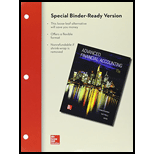
Concept explainers
a
Introduction:
Intercompany transfers: When the intercompany transfer of asset occurs, the parent company must make adjustments in preparing consolidated financial statements as long as the asset is held by the acquiring company. When the asset is transferred at book value no special adjustments are needed. But when the asset is transferred at more or less than the book value, the unrealized gain or loss is deferred until the asset is sold to an unrelated party. Moreover in the consolidation, the gain or loss will be eliminated.
The consolidation entries required to prepare a three-part consolidated worksheet at December 31, 20X9
b
Introduction:
Intercompany transfers: When the intercompany transfer of asset occurs, the parent company must make adjustments in preparing consolidated financial statements as long as the asset is held by the acquiring company. When the asset is transferred at book value no special adjustments are needed. But when the asset is transferred at more or less than the book value, the unrealized gain or loss is deferred until the asset is sold to an unrelated party. Moreover in the consolidation, the gain or loss will be eliminated.
The three part consolidation worksheet for December 31, 20X9.
Want to see the full answer?
Check out a sample textbook solution
Chapter 7 Solutions
LOOSE-LEAF Advanced Financial Accounting with Connect
- Boston Industries completes job #842, which has a standard of 840 labor hours at a standard rate of $22.75 per hour. The job was completed in 890 hours, and the average actual labor rate was $23.10 per hour. What is the labor efficiency (quantity) variance? (A negative number indicates a favorable variance and a positive number indicates an unfavorable variance.)arrow_forwardPlease explain the solution to this general accounting problem with accurate principles.arrow_forwardI am looking for the correct answer to this general accounting question with appropriate explanations.arrow_forward
- Month Monthly Product Demand 2021-01-01 207.55 2021-02-01 208.25 2021-03-01 209.33 2021-04-01 210.11 2021-05-01 213.78 2021-06-01 225.12 2021-07-01 227.19 2021-08-01 218.92 2021-09-01 213.25 2021-10-01 210.75 2021-11-01 215.97 2021-12-01 223.97 2022-01-01 220.54 2022-02-01 213.47 2022-03-01 218.48 2022-04-01 222.07 2022-05-01 222.85 2022-06-01 236.38 2022-07-01 248.60 2022-08-01 234.45 2022-09-01 217.32 2022-10-01 222.56 2022-11-01 237.77 2022-12-01 245.59 2023-01-01 237.75 2023-02-01 213.70 2023-03-01 238.18 2023-04-01 244.78 2023-05-01 233.42 2023-06-01 241.35 2023-07-01 267.98 2023-08-01 249.97 2023-09-01 220.58 2023-10-01 233.12 2023-11-01 240.90 2023-12-01 268.61 2024-01-01 250.80 2024-02-01 225.31 2024-03-01 247.32 2024-04-01 248.50 2024-05-01 237.35 2024-06-01 258.62 2024-07-01 284.45 2024-08-01 256.21 2024-09-01 225.73 2024-10-01 234.07 2024-11-01 263.70 2024-12-01 286.03 Please…arrow_forwardAccounting 12 May I please have a brief summary highlighting one unique feature of the app, recommending it to Sadie—who wants to use some apps for her dog grooming salon to schedule grooming appointments? Thank you so much,arrow_forwardGiven solution for General accounting question not use aiarrow_forward
- Kindly help me with this General accounting questions not use chart gpt please fast given solutionarrow_forwardPlease given correct answer for General accounting question I need step by step explanationarrow_forwardQuiksilver Company sold 4,480 units in October at a price of $63 per unit. The variable cost is $51 per unit. Calculate the total contribution margin. A. $62,060 B. $73,080 C. $56,000 D. $99,750 E. $ 53,760 helparrow_forward
